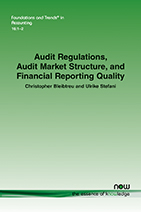Audit Regulations, Audit Market Structure, and Financial Reporting Quality
By Christopher Bleibtreu, BI Norwegian Business School, Norway, christopher.bleibtreu@bi.no | Ulrike Stefani, University of Konstanz, Germany, ulrike.stefani@uni-konstanz.de
Abstract
In order to reduce the high level of concentration in the market segment of statutory audits of listed companies and to improve audit quality, new audit market regulations have been introduced (e.g., the mandatory rotation of the audit firm in the EU and the prohibition of single-provider auditing and consulting in the EU and in the U.S.). Other measures are currently discussed (e.g., joint audits or shared audits in the UK). However, the empirical evidence as to whether such regulations have the expected effects and whether there is actually a negative correlation between concentration and audit quality is mixed. This could be because the effects of regulatory measures on auditor and auditee incentives and their effects on market structure are interdependent, and, moreover, simultaneously determine audit quality. We therefore do not only provide a structured overview of the empirical literature on the effects of audit market regulations, but also discuss how to analyze these effects based on analytical models.
Audit Regulations, Audit Market Structure, and Financial Reporting Quality
Audit Regulations, Audit Market Structure, and Financial Reporting Quality provides a structured overview of the empirical and analytical literature on the effects of audit market regulations. After a short introduction, the monograph is organized as follows. Chapter II addresses the structure of the audit markets of industrialized countries. First presenting an overview of the concentration metrics used to describe the structure of an audit market or a market segment, then providing the empirical findings on audit market concentration at the national level and presenting an overview of the main reasons that led to the currently high degree of concentration. Chapter III summarizes the reasons why regulators worldwide consider a high degree of concentration to be a concern. In particular, it reviews the regulator’s assumption that a high degree of concentration inevitably leads to a low degree of competition and to the corresponding effects of low audit quality and high audit fees. It also provides an overview of the empirical findings on the association between concentration and audit quality and fees, respectively. Chapter IV introduces the mandatory audit firm rotation, the prohibition on the joint supply of audit and non-audit services, and joint audits as examples for regulations that are likely to have both incentive and market structure effects. Chapter V summarizes the empirical findings on the effects of these regulations on audit quality and market structure. Chapter VI summarizes models that regard the market structure as given. The results from these models show that the effects of regulations are not straightforward, but depend on various factors related to the auditor, the client, and the legal environment. Chapter VII gives an overview of analytical research that simultaneously considers incentive effects and market structure effects. It also provides a brief overview of industrial organization models that seem suitable to expand the models applied to investigate the effects of audit regulations. Chapter VIII concludes and highlights avenues for future research.
